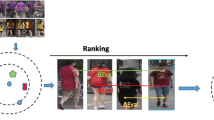Abstract
This paper presents a deep ranking model with feature learning and fusion supervised by a novel contrastive loss function for person re-identification. Given the probe image set, we organize the training images into a batch of pairwise samples, each probe image with a matched or a mismatched reference from the gallery image set. Treating these pairwise samples as inputs, we build a part-based deep convolutional neural network (CNN) to generate the layered feature representations supervised by the proposed contrastive loss function, in which the intra-class distances are minimized and the inter-class distances are maximized. In the deep model, the feature of different body parts are first discriminately learned in the convolutional layers and then fused in the fully connected layers, which makes it able to extract discriminative features of different individuals. Extensive experiments on the public benchmark datasets are reported to evaluate our method, shown significant improvements on accuracy, as compared with the state-of-the-art approaches.
Access this chapter
Tax calculation will be finalised at checkout
Purchases are for personal use only
Similar content being viewed by others
Notes
- 1.
The contrastive loss function: \(\mathrm{P}(\mathbf {X}_i,\mathbf {X}_j)=(1-y_{ij}){\max }\{M_c -d(\mathbf {X}_i,\mathbf {X}_j),0\}+y_{ij}d(\mathbf {X}_i,\mathbf {X}_j)\), where \(M_c\) is the margin parameter.
- 2.
The data set is available at http://vision.soe.ucsc.edu/?q=node/178.
- 3.
The data set is available at http://www.homeoffice.gov.uk/science-research/hosdb/i-lids/.
References
Ahmed, E., Jones, M., Marks, T.K.: An improved deep learning architecture for person re-identification. Differences 5, 25 (2015)
Branch, H.: Imagery library for intelligent detection systems (i-lids). In: The Institution of Engineering and Technology Conference on Crime and Security, 2006, pp. 445–448. IET (2006)
Davis, J.V., Kulis, B., Jain, P., Sra, S., Dhillon, I.S.: Information-theoretic metric learning. In: Proceedings of the 24th International Conference on Machine learning, pp. 209–216. ACM (2007)
Ding, S., Lin, L., Wang, G., Chao, H.: Deep feature learning with relative distance comparison for person re-identification. Pattern Recogn. 48(10), 2993–3003 (2015)
Globerson, A., Roweis, S.T.: Metric learning by collapsing classes. In: Advances in Neural Information Processing Systems, pp. 451–458 (2005)
Gray, D., Tao, H.: Viewpoint invariant pedestrian recognition with an ensemble of localized features. In: Forsyth, D., Torr, P., Zisserman, A. (eds.) ECCV 2008. LNCS, vol. 5302, pp. 262–275. Springer, Heidelberg (2008). doi:10.1007/978-3-540-88682-2_21
Hu, W., Tan, T., Wang, L., Maybank, S.: A survey on visual surveillance of object motion and behaviors. IEEE Trans. Syst. Man Cybern. C Appl. Rev. 34(3), 334–352 (2004)
Li, W., Zhao, R., Xiao, T., Wang, X.: DeepReID: deep filter pairing neural network for person re-identification. In: 2014 IEEE Conference on Computer Vision and Pattern Recognition (CVPR), pp. 152–159. IEEE (2014)
Li, Z., Chang, S., Liang, F., Huang, T.S., Cao, L., Smith, J.R.: Learning locally-adaptive decision functions for person verification. In: 2013 IEEE Conference on Computer Vision and Pattern Recognition (CVPR), pp. 3610–3617. IEEE (2013)
Liao, S., Hu, Y., Zhu, X., Li, S.Z.: Person re-identification by local maximal occurrence representation and metric learning. In: Proceedings of the IEEE Conference on Computer Vision and Pattern Recognition, pp. 2197–2206 (2015)
Mignon, A., Jurie, F.: PCCA: a new approach for distance learning from sparse pairwise constraints. In: 2012 IEEE Conference on Computer Vision and Pattern Recognition (CVPR), pp. 2666–2672. IEEE (2012)
Morris, B.T., Trivedi, M.M.: A survey of vision-based trajectory learning and analysis for surveillance. IEEE Trans. Circ. Syst. Video Technol. 18(8), 1114–1127 (2008)
Paisitkriangkrai, S., Shen, C., van den Hengel, A.: Learning to rank in person re-identification with metric ensembles. In: Proceedings of the IEEE Conference on Computer Vision and Pattern Recognition, pp. 1846–1855 (2015)
Weinberger, K.Q., Blitzer, J., Saul, L.K.: Distance metric learning for large margin nearest neighbor classification. In: Advances in Neural Information Processing Systems, pp. 1473–1480 (2005)
Xiong, F., Gou, M., Camps, O., Sznaier, M.: Person re-identification using kernel-based metric learning methods. In: Fleet, D., Pajdla, T., Schiele, B., Tuytelaars, T. (eds.) ECCV 2014. LNCS, vol. 8695, pp. 1–16. Springer, Heidelberg (2014). doi:10.1007/978-3-319-10584-0_1
Yi, D., Lei, Z., Liao, S., Li, S.Z.: Deep metric learning for person re-identification. In: 2014 22nd International Conference on Pattern Recognition (ICPR), pp. 34–39. IEEE (2014)
Zhang, S., Wang, J., Wang, Z., Gong, Y., Liu, Y.: Multi-target tracking by learning local-to-global trajectory models. Pattern Recogn. 48(2), 580–590 (2015)
Zhao, R., Ouyang, W., Wang, X.: Learning mid-level filters for person re-identification. In: 2014 IEEE Conference on Computer Vision and Pattern Recognition (CVPR), pp. 144–151. IEEE (2014)
Acknowledgments
This work is partially supported by National Basic Research Program of China (973 Program) under Grant No. 2015CB351705, and the National Science Foundation of China under Grant No. 61473219.
Author information
Authors and Affiliations
Corresponding author
Editor information
Editors and Affiliations
Rights and permissions
Copyright information
© 2016 Springer International Publishing AG
About this paper
Cite this paper
Zhou, S., Wang, J., Hou, Q., Gong, Y. (2016). Deep Ranking Model for Person Re-identification with Pairwise Similarity Comparison. In: Chen, E., Gong, Y., Tie, Y. (eds) Advances in Multimedia Information Processing - PCM 2016. PCM 2016. Lecture Notes in Computer Science(), vol 9917. Springer, Cham. https://doi.org/10.1007/978-3-319-48896-7_9
Download citation
DOI: https://doi.org/10.1007/978-3-319-48896-7_9
Published:
Publisher Name: Springer, Cham
Print ISBN: 978-3-319-48895-0
Online ISBN: 978-3-319-48896-7
eBook Packages: Computer ScienceComputer Science (R0)




